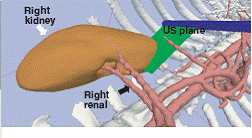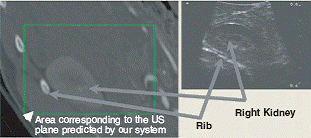
Bubble Ultrasound-Guided Biopsy/ Surgery
BME 240
| |
| Home |
| Background |
| Applications |
| Future |
| References |
| Future |
Surgical procedures The Voshurgh group from MIT has described a system in where the surgeon would be able to view three separate images during the operation; they include a 3D CT model, CT oblique slices, and ultrasound. Figure 10 shows one example where the three images offer different perspectives of the same location. [13] Although new, the utilization of ultrasound enhanced by contrast microbubbles may greatly improve the accuracy and potential of many current surgical procedures |
Figure 10. Left to right; Oblique CT slices, Ultrasound, and 3D CT-model [13] |


